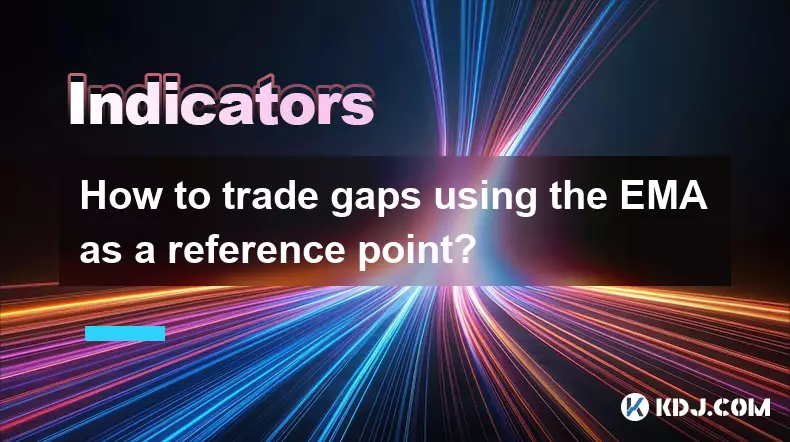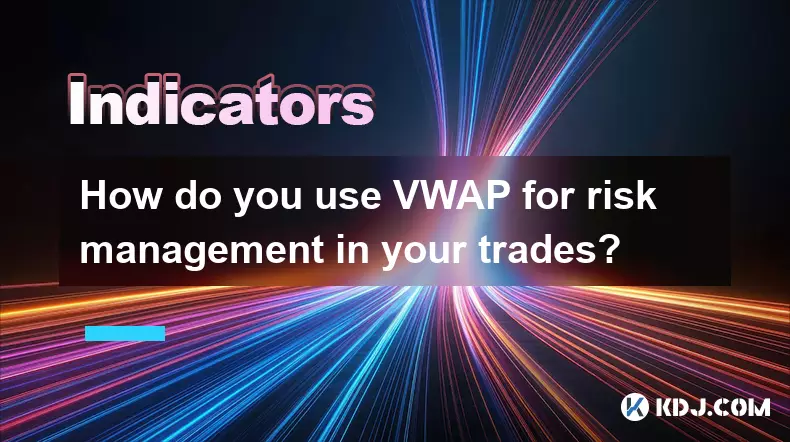-
 bitcoin
bitcoin $114684.631706 USD
-0.87% -
 ethereum
ethereum $4228.677447 USD
1.58% -
 bnb
bnb $1294.880693 USD
-1.16% -
 tether
tether $1.000819 USD
-0.02% -
 xrp
xrp $2.605138 USD
2.79% -
 solana
solana $209.908690 USD
5.89% -
 usd-coin
usd-coin $0.999903 USD
-0.03% -
 dogecoin
dogecoin $0.213423 USD
2.93% -
 tron
tron $0.322721 USD
-0.10% -
 cardano
cardano $0.727247 USD
3.66% -
 hyperliquid
hyperliquid $42.339456 USD
6.05% -
 chainlink
chainlink $19.910811 USD
5.16% -
 ethena-usde
ethena-usde $1.000557 USD
0.00% -
 stellar
stellar $0.349734 USD
2.69% -
 bitcoin-cash
bitcoin-cash $543.848687 USD
-0.21%
How to trade gaps using the EMA as a reference point?
Gaps in crypto markets, though less common due to 24/7 trading, signal potential momentum shifts and are best confirmed using EMA for high-probability trade setups.
Oct 10, 2025 at 05:36 pm

Understanding Gaps in the Context of Cryptocurrency Markets
1. Gaps refer to areas on a price chart where no trading activity has occurred, creating a visible void between two consecutive candlesticks. In fast-moving markets like cryptocurrency, gaps often appear due to sudden shifts in sentiment, news events, or after market closures on certain platforms.
2. These gaps can be classified into several types: common gaps, breakaway gaps, runaway (or continuation) gaps, and exhaustion gaps. Each type signals different potential movements, with breakaway and runaway gaps being particularly relevant for traders using technical tools like EMAs.
3. Because crypto markets operate 24/7 on most exchanges, true gaps are less frequent than in traditional markets but still occur during periods of low liquidity or abrupt price changes following major announcements.
4. Identifying these gaps accurately allows traders to assess momentum and possible reversal or continuation patterns, especially when combined with moving averages such as the Exponential Moving Average (EMA).
Using EMA to Confirm Gap Validity and Direction
1. The EMA assigns greater weight to recent prices, making it more responsive to new information compared to simple moving averages. This responsiveness makes it ideal for confirming whether a gap is likely to hold or get filled.
2. When a gap forms above the current EMA level—particularly the 20-period or 50-period EMA—it may indicate strong bullish momentum, especially if volume accompanies the move. A close above the EMA after the gap increases the likelihood of continuation.
3. Conversely, a gap below the EMA, followed by price remaining under it, suggests bearish strength. Traders watch for rejections at the EMA after the gap to confirm downward pressure.
4. If price quickly returns into the gap area and interacts with the EMA—such as testing it from below after an upward gap—it could signal weakness and a higher chance of the gap filling.
Strategies for Trading Gaps Relative to EMA Levels
1. One approach involves waiting for the price to pull back toward the EMA after a gap. For instance, after a bullish gap, if price retraces to touch or slightly dip under the 20 EMA before bouncing, that can serve as a low-risk entry point for long positions.
2. Confirmation through candlestick patterns near the EMA—like bullish engulfing or hammer formations—adds reliability to the trade setup. Volume spikes during the rejection enhance confidence in the direction.
3. In bearish scenarios, short entries can be considered when price gaps down below the EMA and then uses it as resistance during a retest. A failed attempt to reclaim the EMA supports the validity of the gap as a breakout signal.
4. Stop-loss placement is crucial. For longs after an upside gap, stops can be set just below the lower edge of the gap or beneath the EMA. For shorts, stops go above the upper edge of the gap or above the EMA.
5. Traders who align gap behavior with EMA dynamics reduce false signals and improve risk-to-reward ratios by focusing only on high-probability setups supported by both momentum and structure.
Monitoring Gap Fill Behavior with EMA as Support or Resistance
1. Many gaps in crypto eventually fill, especially common or exhaustion gaps. Observing how price reacts when approaching the gap zone while respecting the EMA provides insight into market intent.
2. If price moves back into a previous gap and finds support or resistance at the same time it touches the EMA, this confluence strengthens the level’s significance. Such zones become key decision points.
3. A filled gap without a strong reaction at the EMA suggests the original move lacked conviction. This may lead to sideways movement or reversal, depending on broader context.
4. Persistent respect for the EMA during gap fills indicates underlying trend strength and helps distinguish between temporary retracements and full reversals.
Frequently Asked Questions
What timeframe is best for identifying tradable gaps using EMA?The 1-hour and 4-hour charts offer a balanced view, filtering out noise while capturing meaningful gaps. Lower timeframes like 5-minute or 15-minute can show too many false gaps, while daily charts might miss timely opportunities.
Can EMA alone confirm a gap trade?No single indicator should be used in isolation. While EMA enhances gap analysis, combining it with volume, order book depth, and candlestick confirmation improves accuracy significantly.
Do all cryptocurrency pairs exhibit gap behavior similarly?Major pairs like BTC/USDT or ETH/USDT tend to have cleaner gap patterns due to higher liquidity. Low-cap altcoins may show erratic price jumps that resemble gaps but are often caused by thin order books rather than genuine momentum.
How do you differentiate a real gap from a slippage spike?Real gaps are sustained and accompanied by increased volume or clear catalysts. Slippage spikes are brief, often reversed within one or two candles, and lack follow-through momentum or alignment with key technical levels like the EMA.
Disclaimer:info@kdj.com
The information provided is not trading advice. kdj.com does not assume any responsibility for any investments made based on the information provided in this article. Cryptocurrencies are highly volatile and it is highly recommended that you invest with caution after thorough research!
If you believe that the content used on this website infringes your copyright, please contact us immediately (info@kdj.com) and we will delete it promptly.
- XRP Price Prediction: Weekend Rollercoaster or Rally?
- 2025-10-12 08:45:16
- Bittensor (TAO): Super Bullish Signals Point to Potential 2x Rally
- 2025-10-11 10:25:12
- Silver Price Correction: Navigating the Dip & Identifying Key SEO Keywords
- 2025-10-11 10:25:12
- Decoding Crypto Trends: Bittensor's Bull Run, Cardano's Dip, and LivLive's Presale Buzz in 'Uptober 2025'
- 2025-10-12 08:45:16
- MoonBull: The Crypto Meme Coin Promising 1000x Gains?
- 2025-10-11 10:30:01
- Crypto Payroll Revolution: Stablecoins, Altcoins, and the Future of Salary Payments
- 2025-10-11 10:30:01
Related knowledge

What's the main difference between VWAP and TWAP?
Oct 12,2025 at 11:54am
Understanding VWAP and Its Role in Crypto Trading1. Volume Weighted Average Price (VWAP) is a trading benchmark that calculates the average price of a...

How do you identify exhaustion moves using VWAP and its bands?
Oct 12,2025 at 08:00am
Understanding the Role of Decentralized Exchanges in Crypto Trading1. Decentralized exchanges (DEXs) operate without a central authority, allowing use...

How do you use VWAP to scale in and out of positions?
Oct 14,2025 at 02:19am
Understanding VWAP as a Dynamic Benchmark1. The Volume Weighted Average Price (VWAP) is not just an indicator—it functions as a dynamic benchmark that...

What are the main advantages of using VWAP over EMA?
Oct 11,2025 at 02:18am
Main Advantages of Using VWAP Over EMA1. Volume-Weighted Average Price (VWAP) incorporates trading volume into its calculation, offering a more accura...

How do you use VWAP on different chart types like Heikin Ashi?
Oct 11,2025 at 05:01pm
Understanding VWAP in the Context of Heikin Ashi Charts1. The Volume Weighted Average Price (VWAP) is a powerful analytical tool commonly used by trad...

How do you use VWAP for risk management in your trades?
Oct 11,2025 at 02:54am
Understanding VWAP as a Dynamic Benchmark1. The Volume Weighted Average Price (VWAP) serves as a crucial reference point in intraday trading by reflec...

What's the main difference between VWAP and TWAP?
Oct 12,2025 at 11:54am
Understanding VWAP and Its Role in Crypto Trading1. Volume Weighted Average Price (VWAP) is a trading benchmark that calculates the average price of a...

How do you identify exhaustion moves using VWAP and its bands?
Oct 12,2025 at 08:00am
Understanding the Role of Decentralized Exchanges in Crypto Trading1. Decentralized exchanges (DEXs) operate without a central authority, allowing use...

How do you use VWAP to scale in and out of positions?
Oct 14,2025 at 02:19am
Understanding VWAP as a Dynamic Benchmark1. The Volume Weighted Average Price (VWAP) is not just an indicator—it functions as a dynamic benchmark that...

What are the main advantages of using VWAP over EMA?
Oct 11,2025 at 02:18am
Main Advantages of Using VWAP Over EMA1. Volume-Weighted Average Price (VWAP) incorporates trading volume into its calculation, offering a more accura...

How do you use VWAP on different chart types like Heikin Ashi?
Oct 11,2025 at 05:01pm
Understanding VWAP in the Context of Heikin Ashi Charts1. The Volume Weighted Average Price (VWAP) is a powerful analytical tool commonly used by trad...

How do you use VWAP for risk management in your trades?
Oct 11,2025 at 02:54am
Understanding VWAP as a Dynamic Benchmark1. The Volume Weighted Average Price (VWAP) serves as a crucial reference point in intraday trading by reflec...
See all articles










































































